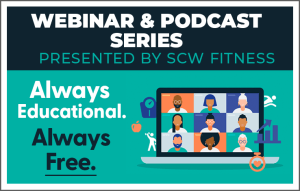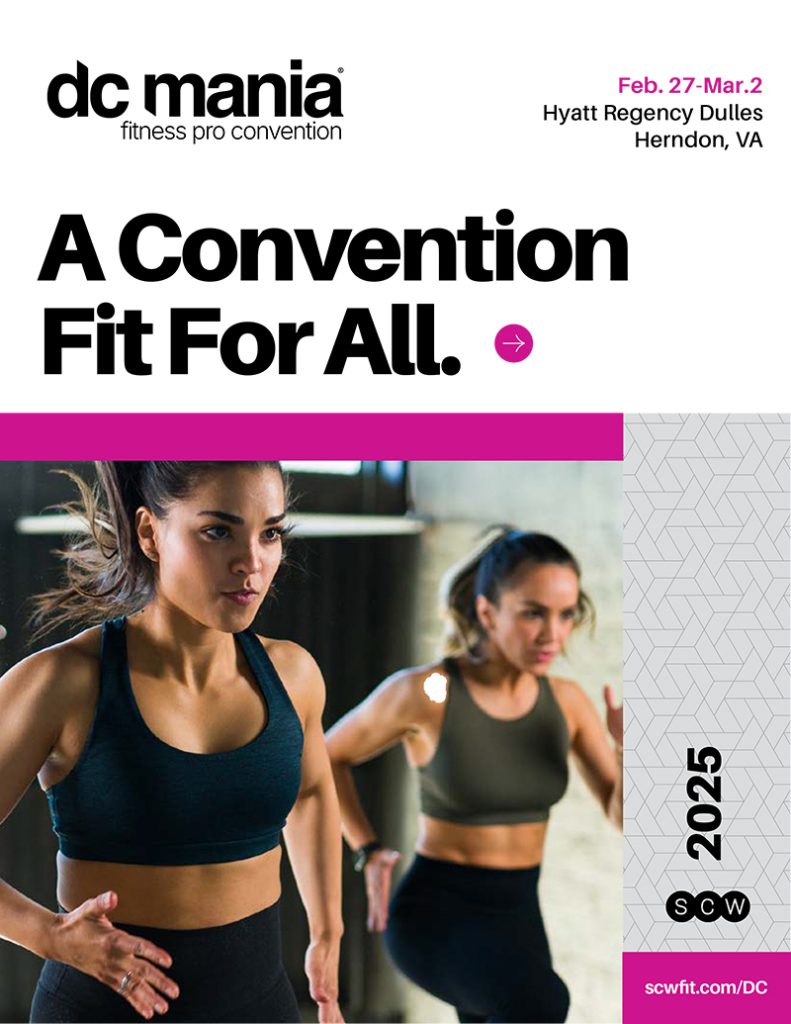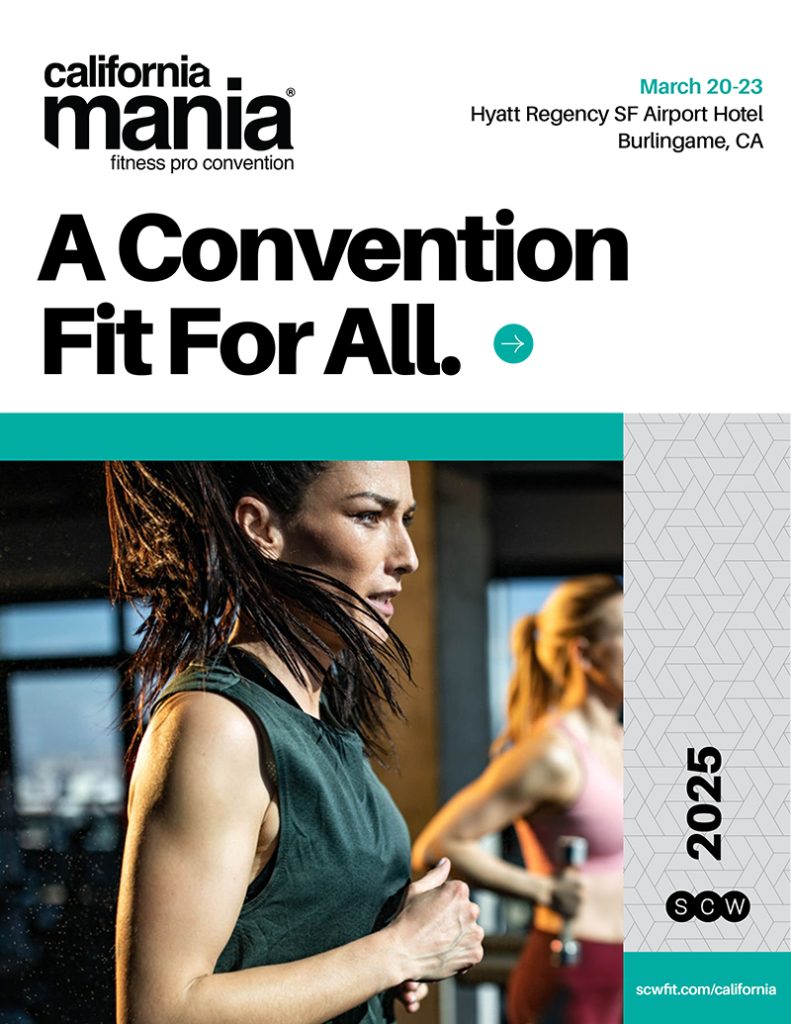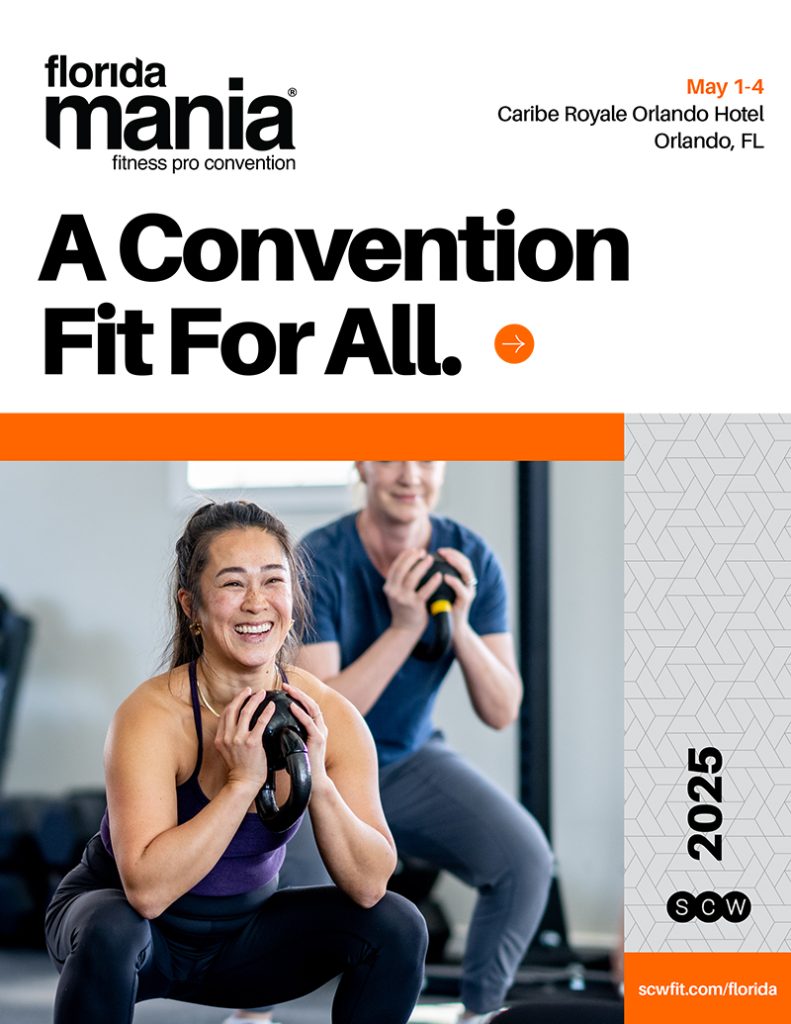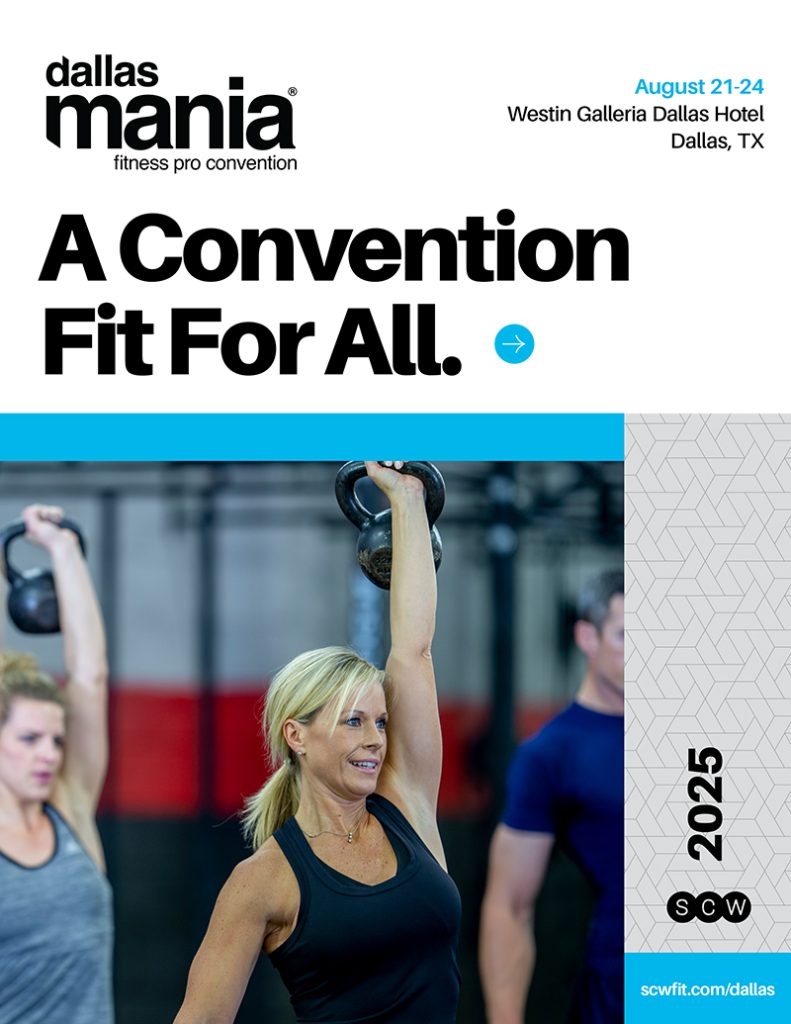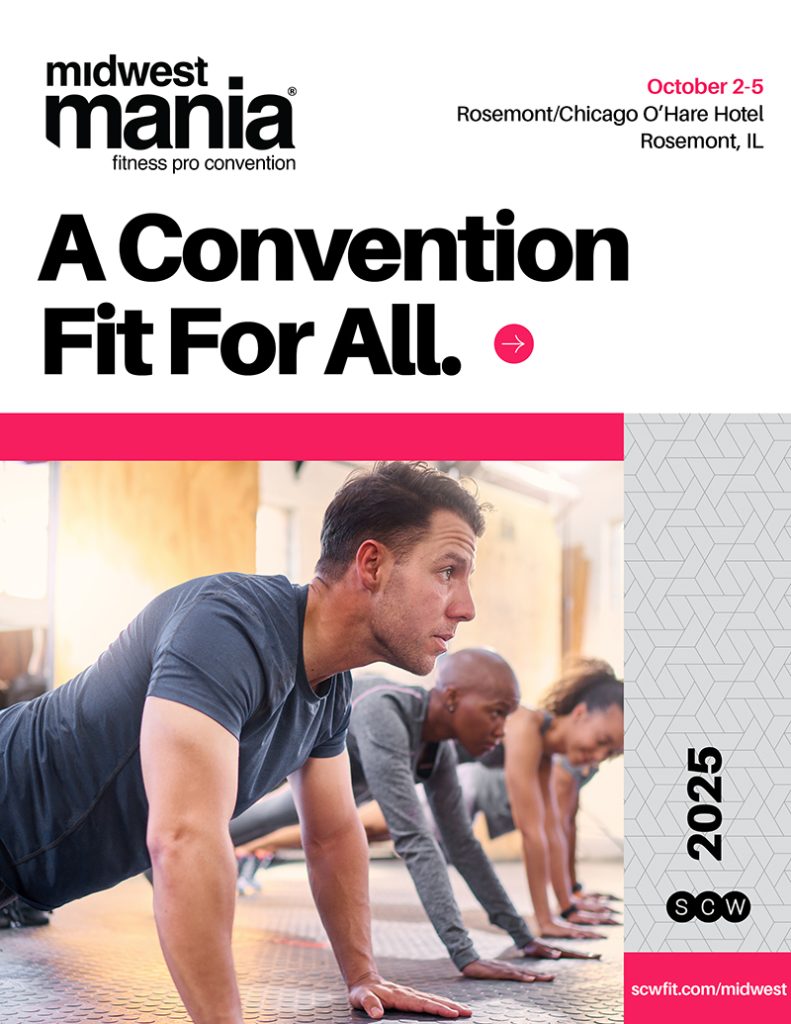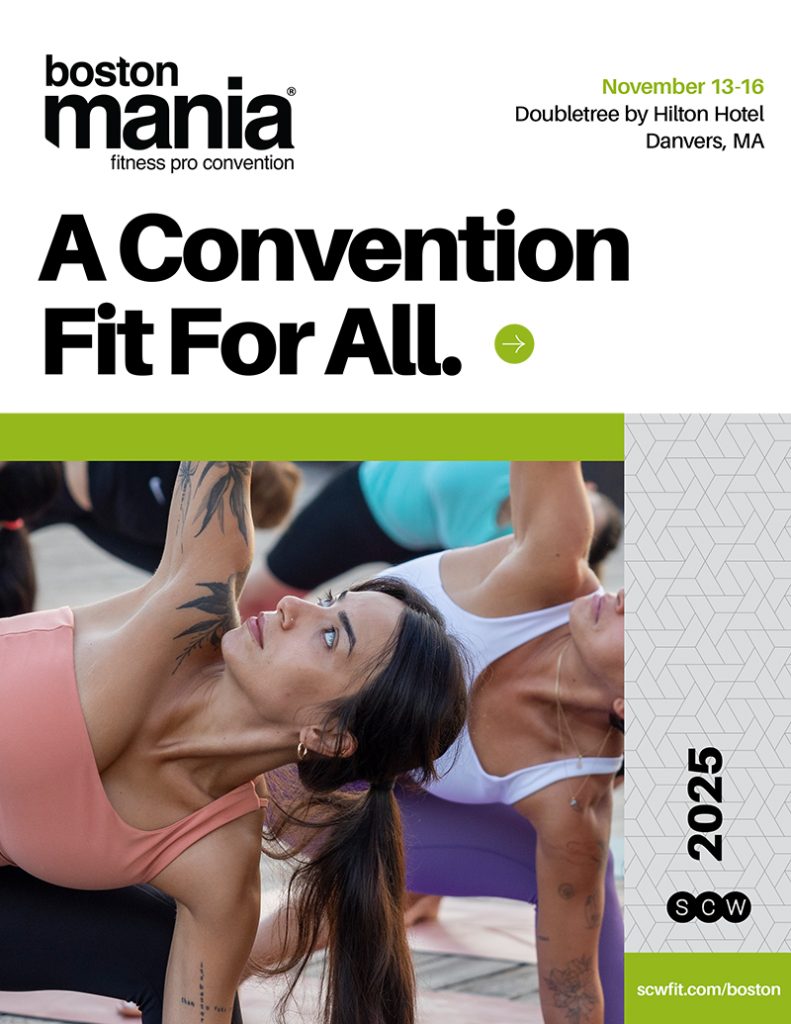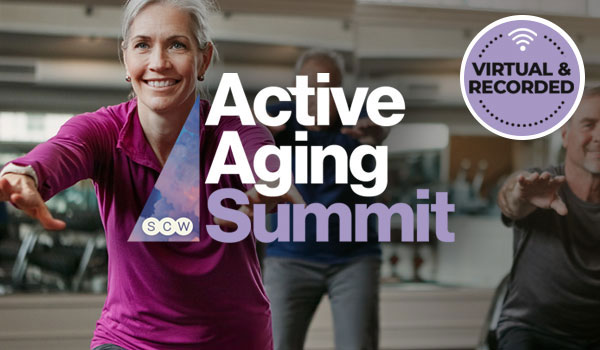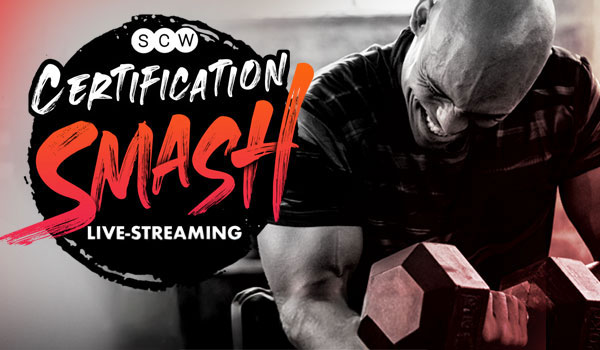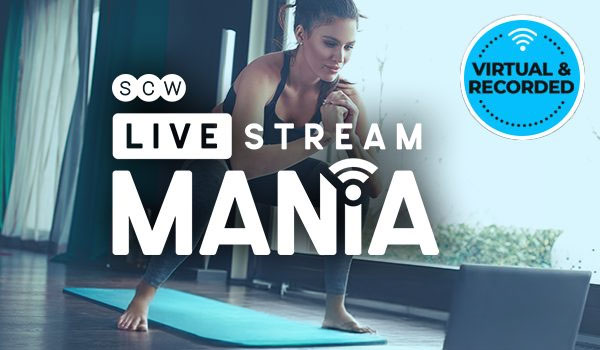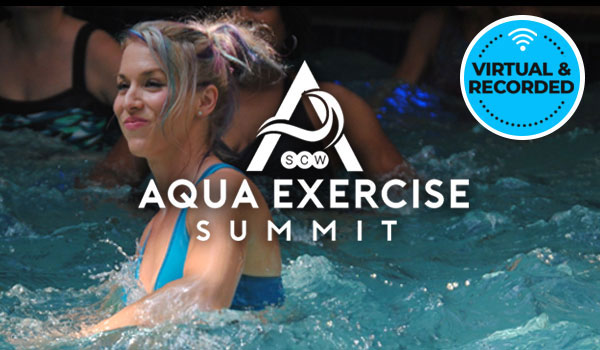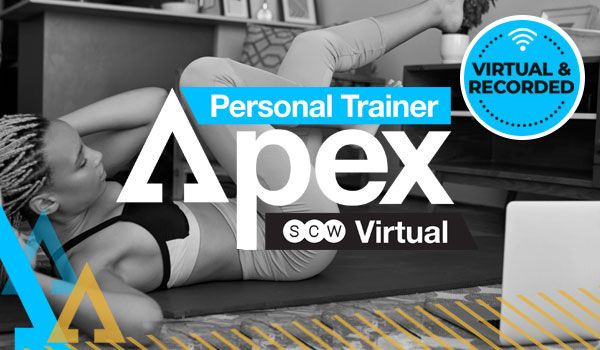
SCW Spotlite: Issue 63

Unraveling the Distinction Between Fitness Pros & Fitness Influencers
In the age of social media, the fitness industry has witnessed a surge in both fitness professionals and fitness influencers viewings for attention and recognition. These two groups may seem similar at first glance; however, let’s take a deeper dive into the differences in their expertise, intentions, and the impact they have on the fitness industry. I hope to shed some light on the contrasting attributes of fitness professionals and fitness influencers.
As fitness professionals, we do our best to lead with research and best practices to help our clients on a daily basis. During the pandemic, we saw an influx of workouts posted by influencers on social media. Fitness professionals were fighting a battle to prevent misinformation from spreading. Now, post-Covid, we are still working to be an experienced presence online, emphasizing safety and refining our education and hard-earned credentials.
While fitness professionals and fitness influencers both contribute to the fitness landscape, their roles and impact differ significantly. Fitness professionals have formal education and certifications, allowing them to provide knowledge and expertise to guide their clients towards their fitness goals safely and effectively. On the other hand, fitness influencers’ popularity is largely driven by their ability to engage and inspire audiences, even though their content may not be backed by science. Recently, I heard a quote that resonated with me: “Brushing your teeth daily doesn’t make you a dentist.”
Defining Fitness Professionals
Fitness professionals are individuals who have recognized accredited certifications and years of expertise in various areas of the fitness industry (Personal Training/Group Exercise). Many have academic backgrounds, such as degrees in exercise science, kinesiology, sports medicine, nutrition background, or related fields. Additionally, many fitness professionals have specialized certifications from reputable organizations such as the National Academy of Sports Medicine (NASM), American Council of Sports Medicine (ACSM), Aerobics Fitness Association of America (AFAA), American Council on Exercise (ACE), and The International Sports Sciences Association (ISSA).
Their knowledge, experience, and coaching allow fitness professionals to design personalized workouts and class routines, as well as assess their clients’ fitness levels and establish goals for them. Many fitness professionals work at fitness centers or health clubs, or have their own personal branded businesses providing one-on-one training or leading group fitness classes. Their primary goal is to help clients achieve their fitness goals safely and effectively, prioritizing health and wellness over aesthetics.
Understanding Fitness Influencers
Fitness influencers are individuals who leverage their social media presence to a large following, often focusing aesthetics and physical appearance. Unlike fitness professionals, many influencers do not have formal education or certifications in fitness-related fields. Their rise to fame is often due to their ability to connect with their audience, showcase their own fitness journeys, and offer motivational content.
Fitness influencers usually share their workouts, nutrition tips, and lifestyle choices, attracting followers who seek inspiration, motivation, or entertainment. Many of them may be mirroring fitness professionals’ workouts on social media. Other influencers’ content will not be rooted in evidence-based practices. What’s often lacking is the “how to” or break down of an exercise progression. That said, many of these workouts are not attainable to the fitness novice. Fitness influencers typically share generalized workouts that are geared strictly for their goals and personal aesthetics, and share content aimed at a broad audience. Additionally, influencers’ focus on physical appearance may overshadow the importance of overall health and well-being.
Credibility and Accountability
Fitness professionals are held accountable by industry standards, codes of ethics, and certification boards. They must renew their certifications annually or every two years and maintain a current CPR certificate in order to work and train in fitness facilities. Fitness influencers are not faced with the same level of scrutiny or bound by professional guidelines. They depend on “likes” which motivates them to continue creating content and focusing more on gaining popularity, brand partnerships, and self-promotion.
As you embark on your fitness journey, it is crucial to recognize the difference in these two roles. Make informed choices based on your individual needs and goals. Collaborating with fitness certified professionals and maintaining an enthusiasm for health and wellness will lead you to a successful career in this rewarding industry. Good luck!
 About the Author: Gail Bannister-Munn
About the Author: Gail Bannister-Munn
Gail Bannister-Munn is the Flexibility Specialist and Core, Yoga, & Pilates Coach with the New York Jets football team. Gail is the owner of The Bannister Method Studio out of Long Island, West Babylon, New York & is the Regional Group Ex Manager of Crunch Fitness Locations (Queens, Bronx, Brooklyn). Gail teaches several different class formats at national conferences and is a Fitness Consultant for professional athletes in the NBA, NFL, NHL, & MLB. She holds numerous certifications in several disciplines, including NASM, AFAA, FST L3, Thai Massage Specialist, Yoga Fit 500+ hrs., and is a NASM & AFAA Continuing Education Provider.
Follow us on IG: https://www.instagram.com/scwmania/
Like our FB page: https://www.facebook.com/scwmania
Follow us on X: https://twitter.com/scw_mania
Connect with us on LinkedIn: https://www.linkedin.com/company/scwfit/

Teaching Consistecy
by Jeff Switalski
 About the Author, Jeff Switalski
About the Author, Jeff Switalski
In 2003 Jeff started his training in NASCAR for Motor Racing Outreach. He spent the next 7 years honing his craft, working with weight loss, functional training, and triathlon training clients. Jeff opened two Crossfit Gyms in 2011 & 2013. During this time, he also spent 12 years training & coaching the Special Olympic Powerlifting Team. In 2017, Jeff had both knees replaced and hiked the AT. In 2019 he opened an intimate studio where he facilitates in-depth training on clients’ bodies, minds, and hearts.
Follow us on IG: https://www.instagram.com/scwmania/
Like our FB page: https://www.facebook.com/scwmania
Follow us on X: https://twitter.com/scw_mania
Connect with us on LinkedIn: https://www.linkedin.com/company/scwfit/

6 Ways to Protect Your Passion and Lower Your Risk
by Miriam Ball
As a fitness entrepreneur, you are passionate about helping others achieve their health and wellness goals. However, along with the rewards of running a fitness business comes the potential for risks and liabilities. That’s where liability insurance comes in – it serves as a safeguard to protect your livelihood and give you peace of mind. There are also effective and easy ways for you to minimize your risk right away.
Understanding Liability Insurance
Liability insurance is a type of coverage that protects you from claims and legal actions against you that arise from accidents, injuries, or property damage that may occur as a result of your fitness business. It provides financial protection by covering legal expenses and other costs you may have to pay. There are a few types of liability insurance and coverage that you should know about.
- General Liability: While you always strive to create a safe environment for your clients, accidents happen. General liability insurance covers medical expenses and legal costs if someone gets injured on your premises (either a specific location or any location at which you are providing your service) or claims their physical possessions were damaged. For example, if someone were to trip over a mat at your gym and fall, resulting in an injury, and they sued you for their medical costs, general liability would activate to provide legal services to defend you and even to pay the injured person’s medical bills if you are determined to be responsible for that injury.
- Professional Liability: If someone thinks your guidance or professional recommendations caused them harm, professional liability insurance acts as a safety net. It covers your legal costs if a client sues you for supposedly giving them bad advice. With professional liability insurance, you’re protected financially, letting you keep helping clients achieve their goals.

- Sexual Molestation Liability: One of the most pressing issues in the fitness industry is the risk of sexual misconduct and harassment claims. For fitness places where trainers work closely with clients, having sexual abuse liability insurance is crucial. If there are allegations or claims about inappropriate behavior (even for something as simple as posting a photo online), this insurance covers legal expenses, counseling, and potential compensation. It shows that you take safety seriously and are prepared to handle such situations responsibly.
- Cyber Liability: Nowadays, fitness centers use digital systems to manage client info, schedules, and payments. But what if hackers get in and steal that data? That’s where cyber liability insurance steps up. If there’s a data breach, this insurance covers the costs of notifying clients, getting the data back, dealing with legal actions, and any fines. It’s all about keeping client trust intact and the business running smoothly.
- Legal Protection: Legal issues can pop up unexpectedly, even in the fitness world. Legal battles can drain finances. That’s where defense costs coverage comes in. It ensures that even if the claims are proven baseless, the business isn’t hit hard financially due to legal fees and court proceedings. Any of the scenarios above could end up determining that you are not at fault for the injury or damage, but legal fees to get to that point can add up quickly. Having insurance to cover the cost of your defense is critical to protecting your business.
Effective Risk Management Strategies
Even if you have liability insurance to protect your work, it is still important to prevent accidents and claims from ever happening. Having effective risk management strategies in place can ensure you keep your high reputation and can prevent loss of clientele due to injuries.
Education and Certification: Acquiring proper certifications from reputable fitness organizations not only enhances your credibility but also equips you with the knowledge and skills needed to provide safe and effective training. Continuous education and staying up-to-date with the latest fitness trends and safety guidelines are essential.
Comprehensive Client Assessment: Before beginning any training program, conduct a thorough assessment of your clients’ medical history, fitness level, and specific goals. Identifying pre-existing conditions or limitations can help tailor workouts that minimize the risk of injury. Maintain open and clear communication with your clients. Encourage them to provide feedback about their comfort level, any discomfort, or concerns during training. Address any issues promptly. Most importantly, keep detailed records of your interactions with clients, including assessment forms, workout plans, progress tracking, and all communication.
Informed Consent: Have clients sign a detailed informed consent and liability waiver form that outlines the potential risks associated with physical training and releases you from liability if they get injured. This document can serve as evidence that clients were made aware of the inherent risks and willingly participated in the training.
*Alternative Balance has FREE templates available for members on the member portal!
Proper Supervision: Always provide attentive supervision during instructor- or trainer-led workouts, especially when clients are performing exercises with a higher risk of injury. Proper form and technique are crucial to prevent accidents.
Safety Protocols: Establish clear safety protocols for your training sessions. This includes proper warm-ups, cool-downs, use of appropriate equipment, and hydration guidelines. Educate your clients about these protocols and ensure they follow them.
Limit Scope of Practice: Stick to what you’re qualified to do. Avoid giving medical advice or nutrition guidance outside your area of expertise. If a client requires specialized care, refer them to appropriate professionals. This can also be a great way to grow your business! Partner up with specialists and refer clients to each other to provide more comprehensive service.
Choosing the Right Liability Insurance
Having appropriate insurance coverage is essential for protecting your fitness business against unforeseen circumstances. At Alternative Balance, we are here to support you in managing risks and protecting your business. Reach out to our team of experts (we are based in New Hampshire) to discuss your insurance needs and how we can help you navigate the unique challenges of the fitness industry. An AB Membership includes comprehensive business insurance and other business resources created specifically for the wellness industry. Our insurance plan includes general and professional liability insurance, participant accident coverage, and business personal property/business interruption coverage for over 750 services, all under one policy, starting at $189/yr. Our simple 2-step application is the easiest and fastest in the industry – get covered in 10 minutes or less, then get back to doing what you love!
If you would like to chat with us in person, join us at Boston MANIA®, November 3-5, at the Doubletree by Hilton Northshore. We are available in the expo hall (free to attend) and will also be providing insightful sessions throughout the weekend. As an added bonus, MANIA® Attendees save $20 when on a membership, www.alternativebalance.com/scw. For more information and to register visit www.scwfit.com/boston. We look forward to meeting you and helping you choose the right protection for your business.
 About the Author: Miriam Ball
About the Author: Miriam Ball
Miriam Ball is the CIO and a licensed property & casualty broker at Alternative Balance LLC. She specializes in developing insurance programs for the health, beauty, and wellness industries. Over the past 20 years, Miriam has developed policy forms and website systems for insureds across the US.
Follow us on IG: https://www.instagram.com/scwmania/
Like our FB page: https://www.facebook.com/scwmania
Follow us on X: https://twitter.com/scw_mania
Connect with us on LinkedIn: https://www.linkedin.com/company/scwfit/

How to Grow Your Client List Without a Big Following or Paid Ads
by Brandi Clark
Here is how it goes…
You make a big announcement on Instagram or Facebook about your new program. As you press “post” you’re sure that everyone you’ve known since third grade will start commenting and flock to you for your amazing help.
The reality: the only person that likes your post is your mom and your aunt Torri.
No one is asking about your services, so you creep a few private groups, maybe make a few unauthorized promotional posts and get booted. Ultimately feel frustrated and claim that online training is dead, and you go back to work at the gym down the street.
If this sounds like you, it’s ok and it’s definitely not your fault. No one is born a natural marketer.
You were busy studying anatomy, biomechanics, and behavioral psychology, NOT business and marketing, which are two subjects are not covered in your certification programs. Knowing how to market yourself is a challenge most fitness professionals struggle with when it comes to finding and enrolling clients using social media.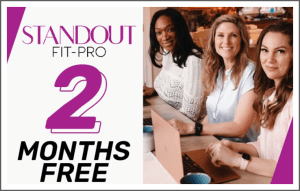
They can’t seem to get noticed. Nobody comments or engages with their posts. They can’t grow their following no matter how hard they try.
But…and listen when I say this…because here is the problem: You’re not looking at yourself as a business or brand.
If you are serving clients, if your paycheck depends on how many people you work with, and you have dreams of creating more impact, positive influence, and income…You are now a Business and a Brand. Period. End of subject.
So…congratulations on your new business! LOL
In all seriousness, let’s chunk out what you need to do to start looking at yourself as a business; so you can stand out on social media and so people will notice you, pay attention to your content, and want to work with you.
**NOTE: As you work thru these steps, I invite you to do each of the action items on paper and send them to me via email at hello@standoutfitpro.com. I’ll take a look and email you back with my thoughts.
Step 1: BE YOU
Yup, I invite you to be 100% authentically you. Let your fun, quirky, serious, type A or type B personality show all over social media. This lets people instantly love you or move on quickly. Allowing people to love you or move on quickly sounds scary, but it really isn’t. Doing this creates a very loyal tribe of followers who stay and pay.
In my own business my brand highlights how much I love coffee, how I ADORE fake lashes, how most of my days are spent working my business in a messy bun and my Lulus. In fact, even my IG handle is @themessyhairmillionaire, (let’s connect there). People who think I am ridiculous for loving lashes, coffee, and Lulu’s get to move on.
ACTION ITEM: What are some fun or unique things about you? Hint: these may be things you have been trying to hide or decided not to talk about on social media because “no one cares.”
Step 2: WHAT IS YOUR SOLUTION?
What things do you believe people should be doing in order to get results and KEEP those results? Why AREN’T they getting results already (hint: probably because they aren’t following your steps. LOL)? Should they be counting macros? Keto? HIIT training? Hot Yoga? What is it that you wish people would understand and if they finally understood these simple things…they would FINALLY get results? This is your solution. Now start to talk about it daily on social media.
In my own business I believe so deeply that if people understood how to organically use social media it would change their lives. They would have a continual list of new people wanting to work with them, they would have a waiting list for their next program or opening and their impact on the world would far surpass anything they can create locally.
ACTION ITEM: What do you wish people would understand and actually DO that would change their live as it pertains to weight loss, fitness, health and/or wellness?
Step 3: WHAT ARE PEOPLE DOING WRONG?
What are people doing all wrong? How are they messing up the process and making it more difficult for themselves? These are usually things like giving up, starting over, jumping from diet to diet, cutting all carbs or even the wrong type of training for their age.
In my own business I see people posting on social media with no real strategy. No end result or place where they want people to go. They post just because it is something they are supposed to do, and they don’t know where they are trying to take the follower. I also see people starting low-cost monthly memberships because they think it will be cheap enough that everyone will want to join. It isn’t, and it doesn’t. Because of this, they don’t stand out, nobody pays attention to their content, and they feel frustrated, give up, and stop posting.
ACTION ITEM: Create a list of all the things you see people do wrong as it pertains to your business. Go thru the following lists of questions and answer them on a Google Doc. Then, send me an email at hello@standoutfitpro.com and show me what you have. Let me help you thru the next steps!
Ok, last thing. Now that you know your unique traits to showcase, what your clients SHOULD be doing, and what they are doing WRONG…Start talking about it on social media EVERYDAY because businesses and brands post daily. They don’t worry if someone is annoyed or if someone doesn’t like their post…they post DAILY.
The truth is, no one is going to promote you, but you.
YOU get to step into the position of confidence and tell the world what you do.
YOU get to step into the position of CEO and market your business every day.
YOU get to step into the position of knowing that each day someone is waiting to hear from you and DESPERATELY wanting your help.
But looking at yourself like a business is the only way to get past the fear and insecurities that come along with this position.
You can do it, and I can’t wait to read your action items when you email them to me. Don’t forget!
Oh, and If you’re looking for help with ideas on what you should ACTUALLY say on social media, grab our free list of 90 Days Of Content For The Fitness Professional right here: https://www.standoutfitpro.com/90-days-of-content
I’d love to meet you in-person. Join me at SCW Boston MANIA®, November 3-5 at the DoubleTree by Hilton Northshore. Come and stop by my booth, STANDOUT FIT-PRO in the FREE vendor expo or register for 1, 2, or 3 days of health, nutrition, fitness, and business education guaranteed to boost your skills, connections, business/brand, and of course fun factor at my sessions throughout the weekend.
 About the Author: Brandi Clark
About the Author: Brandi Clark
Brandi Clark is a marketing and sales coach and mentor for fit pros helping them build the financially successful businesses of their dreams. With over 25 years in the fitness industry, she understands how quickly things change and evolve so she spends her time helping fitness professionals adapt so they don’t get left behind. Her specialty is training others how to create content that connects with their audience so they can build a six-figure training business, making more money to help more people.
Follow us on IG: https://www.instagram.com/scwmania/
Like our FB page: https://www.facebook.com/scwmania
Follow us on X: https://twitter.com/scw_mania
Connect with us on LinkedIn: https://www.linkedin.com/company/scwfit/

Counteracting the Effects of Prolonged Sitting: Empower Your Practice with Corrective Exercise
by Patrick Mummy
As a massage therapist or personal trainer, you’re familiar with the challenges posed by prolonged sitting. The sedentary nature of many occupations can lead to postural imbalances, decreased mobility, and weakened muscles.
However, incorporating corrective exercise into your practice can be a game-changer.
In this article, we will delve into the effects of prolonged sitting and explore how corrective exercise can help you address these issues. By empowering yourself with knowledge and practical tools, you can enhance your ability to support your clients’ well-being effectively.
Understanding the Effects of Prolonged Sitting
Prolonged sitting can take a toll on the body, resulting in various concerns such as muscular imbalances, reduced mobility, and weakened postural muscles. By being aware of these effects, you can better grasp the importance of integrating corrective exercise into your practice.
Below are a few ways that sitting affects your clients:
Muscular Imbalances:
Prolonged sitting can lead to muscular imbalances, particularly in the hips, glutes, and core muscles. The prolonged flexed position of the hip joint can cause certain muscles to become shortened and tight, while others may become weakened and lengthened. This imbalance can result in postural issues, such as anterior pelvic tilt, rounded shoulders, and an increased risk of injuries.
Sitting for extended periods can cause stiffness and decreased range of motion in the joints, particularly the hips, spine, and shoulders. Reduced mobility can hinder proper movement patterns and increase the risk of musculoskeletal imbalances, as well as joint and muscle discomfort. It can also limit our ability to perform everyday activities with ease and efficiency.
Weakened Postural Muscles:
Maintaining poor posture while sitting, such as slouching or hunching over, can weaken the muscles responsible for supporting an upright posture. Over time, this can lead to chronic postural imbalances, discomfort, and increased strain on the neck, back, and shoulders. Weakened postural muscles may contribute to poor alignment and compromised spinal health.
Impaired Circulation:
Sitting for prolonged periods can negatively affect circulation, as it reduces blood flow and lymphatic drainage in the body. This can result in fluid retention, decreased nutrient delivery to tissues, and impaired waste removal. Inadequate circulation may contribute to feelings of fatigue, swelling in the legs and feet, and an increased risk of certain health conditions.
Increased Health Risks:
Studies have linked prolonged sitting to an increased risk of various health issues, including obesity, diabetes, cardiovascular diseases, and certain types of cancer. Sitting for extended periods without breaks for movement or exercise can impact metabolic function, insulin sensitivity, and overall cardiovascular health.
The Power of Corrective Exercise
Corrective exercise offers targeted solutions to counteract the effects of prolonged sitting. By incorporating specific exercises into your client sessions, you can address muscular imbalances, improve joint mobility, and strengthen postural muscles.
This approach empowers your clients to regain balance, alleviate discomfort, and optimize their overall movement patterns.
Integrating Corrective Exercise into Your Practice: To effectively integrate corrective exercise into your practice, consider the following steps:
Assess: Begin by assessing your clients’ postural imbalances, movement limitations, and specific needs. This evaluation will guide you in tailoring a personalized corrective exercise program.
Educate: Share your knowledge with clients, teaching them about the effects of prolonged sitting and the benefits of corrective exercise. By educating them, you empower them to take an active role in their own well-being.
Implement: Incorporate corrective exercises into your client sessions, ensuring proper form and technique. Monitor their progress and adjust the program as needed to address their evolving needs.
Small Movements Make Big Changes
Incorporating corrective exercise into your massage therapy or personal training business can be a catalyst for transformative change.
By understanding the effects of prolonged sitting and harnessing the power of targeted exercises, you can revolutionize your approach to client care. Assessing individual needs, educating clients about the benefits of corrective exercise, and implementing personalized programs, can empower your clients to regain balance, enhance mobility, and strengthen postural muscles.
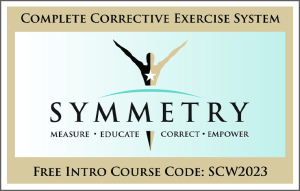 Embrace this journey of continuous learning and adaptation, as it holds the key to elevating your practice and making a lasting impact on the well-being of your clients. By leveraging corrective exercise as a valuable tool, you can unlock the full potential of your practice and create a positive ripple effect in the lives of those you serve.
Embrace this journey of continuous learning and adaptation, as it holds the key to elevating your practice and making a lasting impact on the well-being of your clients. By leveraging corrective exercise as a valuable tool, you can unlock the full potential of your practice and create a positive ripple effect in the lives of those you serve.
Remember, the power of corrective exercise lies in its ability to counteract the effects of sedentary lifestyles and empower individuals to reclaim optimal movement and well-being. Embrace this transformative approach and witness the profound difference it can make in your practice and the lives of your clients.
Together, let’s ignite transformation and unleash the boundless possibilities that await through the integration of corrective exercise into your practice.
If you would like to experience the power of corrective exercise, join the Symmetry for Health Team at SCW Boston MANIA®, November 3-5, at the DoubleTree by Hilton Northshore. Take advantage of a personal posture measurement and attend alignment and postural educational sessions throughout the weekend. If you are unable to attend, but would like more information, please visit our website at www.symmetryalignsmart.com.
 About the Author: Patrick Mummy
About the Author: Patrick Mummy
Patrick earned a baseball scholarship to San Diego State University & graduated with a bachelor’s degree in athletic training. He founded Symmetry for Health & was awarded a patent on a measurable system for postural assessment and corrective exercise – AlignSmart Technology. Patrick has written three books, the latest – “The Physics of Pain; becoming Pain-Free”. He has spoken on the subject of postural assessment at multiple conferences & corporations.
Follow us on IG: https://www.instagram.com/scwmania/
Like our FB page: https://www.facebook.com/scwmania
Follow us on X: https://twitter.com/scw_mania
Connect with us on LinkedIn: https://www.linkedin.com/company/scwfit/

Oh, Yes You Can: Exercise After Breast Surgery
By: Ann Gilbert
Breast Cancer is the most common type of cancer in women, but according to the American Cancer Society, it has the highest survival rate of any in the books. There are numerous studies that have reviewed the effects of regular exercise in patients or clients diagnosed with breast cancer. Evidence proved that regular exercise after diagnosis improved mortality, fatigue, and overall quality of life, not to mention emotional wellbeing. Thus, exercise is now seen as a treatment in positive physiological and psychological improvements after breast cancer surgery.
General Guidelines:
After you get your “ok” from the doctor, it’s recommended to start slowly and with simple moves. A basic program includes:
- Arm Raises – Raising your arms to shoulder height and back down as many as 3-4 times a day. This type of movement allows lymph fluid to flow out of your arm area and helps to restore mobility leading to more advanced activities of daily life.
- Flexion & Extension – Flex and extend the elbow joint while seated in a comfortable chair and touch your fingers to your chest, shoulder and then over your shoulder, only if it feels comfortable. Repeat as many as 20 times and be mindful of your breathing, inhaling and exhaling, with deliberate focus on expanding the diaphragm. Stop all movement patterns if swelling or tenderness occurs.
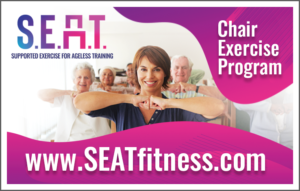 When participating in regular exercise there is a 50% reduced risk of recurrence in our group when compared to the sedentary groups. The benefits also include a decrease in depression and anxiety, and an increase in sleep. All of which are a challenge during the treatment weeks following surgery.
When participating in regular exercise there is a 50% reduced risk of recurrence in our group when compared to the sedentary groups. The benefits also include a decrease in depression and anxiety, and an increase in sleep. All of which are a challenge during the treatment weeks following surgery.
As a certified trainer and breast cancer survivor, I am speaking out to recommend two specific types, modes, or formats which are appropriate for survivors in weeks 4-12 post surgery. The first recommendation is to seek out a well-planned seated chair program in which each segment has a clear purpose, like S.E.A.T. Fitness. This allows the survivor to focus on mobility, postural alignment, memory, balance, and resistance training. The program should address all aspects of fitness for the patient, client or student returning to your facility or online sessions.
The use of a chair as a stabilization tool provides an increase in overall confidence as the patient restarts the fitness journey. The program you choose should incorporate a slow increase in lever, or arm length, thoracic rotation, single leg movements, and essential joint movements addressing speed, power, and even balance.
As a trainer or therapist, I suggest that developing a communication trail with the survivor’s treatment team, doctors, and oncologists. They will become immediate networking partners and providers for future clients and students.
Next, encourage starting a water fitness program, like WATERinMOTION®. The properties of buoyancy, drag, and viscosity make the aquatic environment very appropriate for the survivor. The water creates a light and playful experience, along with less self-consciousness once chest deep. Hydrostatic pressure will shorten the conditioning phase of the exercise program and aid in overall recovery.
The following movements can be completed in a chair, in the pool or when lying down in the supine position. Let’s get started.
Exercise 1. Increase the mobility of the shoulder by gently sliding a small towel up the wall while standing a few inches from the wall. If seated, gentle slide the small towel along the length of the thighs. (Repeat the movement 5-10 times.)
Exercise 2. While sitting in a chair with a lengthened spine and with weight in your heel, flex the spine from right to left, while holding your hands over your head. (Repeat the movement 5-10 times.)
Exercise 3. Commonly called the open-door stretch, the “w” position of the arms allows for an aggressive stretch of the pectorals and a reciprocal contraction through the postural muscles of the mid back or thoracic region. Bend the elbows in what would be considered a “w”, sliding the elbows down towards the hip joint. Plank forward slightly as if to fall through an open door. Return to the starting position. (Repeat the movement 5-7 times.)
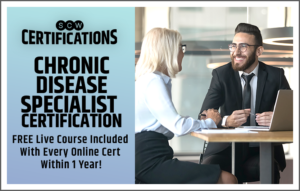 Exercise 4. Lie in the supine position with knees bent. Gently slide a ruler, wand or broom stick over the head starting at the belly. The elbows stay soft, and the focus is on increasing the range of motion at the shoulder area. While in that position one can bend the elbows and slide the fingers behind the upper back while mobbing in a wing in and wing out movement pattern. (Repeat the movement 5-7 times.)
Exercise 4. Lie in the supine position with knees bent. Gently slide a ruler, wand or broom stick over the head starting at the belly. The elbows stay soft, and the focus is on increasing the range of motion at the shoulder area. While in that position one can bend the elbows and slide the fingers behind the upper back while mobbing in a wing in and wing out movement pattern. (Repeat the movement 5-7 times.)
Exercise is safe and very feasible for breast cancer survivors. I most cases, it is prescribed as a part of a treatment plan within 4-12 week of surgery. Exercise has an impact on mortality, prognosis, and overall quality of life. I recommend a multidisciplinary approach that includes both strength and aerobic exercise.
As a Survivor, I would like you all to know that early detection, aggressive nutritional change, and exercise consistency have all been instrumental in my physical and mental growth in my recovery. The word “remission” is whispered nightly as I say my amens, lay that head on the pillow and plan my exercise for the next day.
 About the Author: Ann Gilbert
About the Author: Ann Gilbert
Ann Gilbert is a Breast Cancer Survivor (in remission since June 2021), the creator and choreographer of S.E.A.T. (Supported Exercise for Ageless Training), and a master trainer for WATERinMOTION®. She is also a premier educator on exercise and aging, developing several recognized professional fitness certifications. Ann is the owner and operator of Shapes Fitness for Women, has received ACE/IHRSA Personal Trainer of the Year, and regularly presents at IHRSA, FBA-Succeed, Club Industry, SCW MANIA®, and IAFC. In her spare time, Ann spends time with her precious family and dogs.
Follow us on IG: https://www.instagram.com/scwmania/
Like our FB page: https://www.facebook.com/scwmania
Follow us on X: https://twitter.com/scw_mania
Connect with us on LinkedIn: https://www.linkedin.com/company/scwfit/

Empowering the Future of Fitness
SCW Fitness Education, a leading organization in the fitness and wellness industry, is thrilled to announce the recipients of the prestigious Michael Scott Scudder Scholarship. These outstanding individuals have demonstrated exceptional dedication and promise in the field of fitness and wellness, embodying the values and vision of our dear friend Michael Scott Scudder.
The Michael Scott Scudder Scholarship is an initiative established in his honor following his unexpected passing in 2017. Michael was a luminary in the fitness industry and was an esteemed presenter at the MANIA® Fitness Pro Conventions. The scholarship aims to provide financial support and educational opportunities to Fitness Facility Owners, Managers, Directors, Personal Trainers, and Group Exercise Instructors who share Michael’s passion for excellence and commitment to the fitness community.
The 2023 Michael Scott Scudder Scholarship winners are:
1. James Lucas (MI)
2. Patricia Donahue-Thorpe (IL)
3. Wendy Souza (CA)
4. LeAnna Sheehan (MA)
5. Michelle Harris (PA)
6. Mikella Chrisman (IN)
7. Christipher Sanchez (AK)
8. Stacy Ford (OH)
9. Lacey Lucas (MI)
10. Anna Dujakovic (IN)
11. Amy Garcia (TX)
12. Rosa Coker (GA)
13. Lita Rafael (FL)
14. Denise Elfenbein (CA)
Each of these exceptional individuals has shown exemplary commitment to the fitness industry and a deep understanding of the impact it can have on people’s lives. Their dedication to their craft and their communities aligns perfectly with the values upheld by SCW Fitness Education and the legacy of Michael Scott Scudder.
 The scholarship recipients will receive complimentary attendance to the MANIA® Fitness Pro Convention of their choice, where they will have the opportunity to gain invaluable insights, network with industry leaders, and further their knowledge and skills in the world of fitness and wellness.
The scholarship recipients will receive complimentary attendance to the MANIA® Fitness Pro Convention of their choice, where they will have the opportunity to gain invaluable insights, network with industry leaders, and further their knowledge and skills in the world of fitness and wellness.
“We are incredibly proud to announce these deserving scholarship winners,” said Sara Kooperman, JD, CEO at SCW Fitness Education. “Michael Scott Scudder’s legacy lives on through these individuals, who are poised to make a lasting impact in the fitness and wellness industry. We look forward to supporting and empowering them on their journeys.”
For more information about the Michael Scott Scudder Scholarship and SCW Fitness Education’s commitment to advancing the fitness and wellness community, please visit https://www.scwfit.com/scudder.
SCW Fitness Education is dedicated to fostering excellence in the fitness and wellness industry. With a legacy of 40 years, we are committed to providing education, support, and resources to fitness professionals and enthusiasts worldwide.
Congratulations to all the winners!
Follow us on IG: https://www.instagram.com/scwmania/
Like our FB page: https://www.facebook.com/scwmania
Follow us on X: https://twitter.com/scw_mania
Connect with us on LinkedIn: https://www.linkedin.com/company/scwfit/

Macronutrients: The Key to Survival
Part 4: Water
The fourth and final component in our macronutrients series is water. Although water doesn’t have calories, it is essential for our survival as humans. We can only last about three days without it before we die of dehydration. Every single cell in our body is filled with water. It is present in the blood, skin, organs, and bones.
There are many different opinions on how much water is sufficient. You’ll see some gurus touting a gallon a day is a MUST. The old school recommendation was 64 ounces a day. Some professionals encourage half of your body weight in total of ounces a day. It is true that individuals differ and finding an amount that works for you is important…but how do you know how much?
 The very first sign is to check the color of your urine. It should be a light yellow or clear – light enough that you can see through it. One caveat of this test is medication. Some medication can change the color of your urine. Also be aware that some foods, like blackberries, beets and fava beans can change the color as well. As long as these factors are not in play, if your urine is darker in color, this may be a sign that you are not well hydrated. Depending on how much water you currently consume, begin adding a little extra at a time. A good habit is to have a glass of water when you first wake up. You can count any beverage that does not contain caffeine or alcohol into your water count. Why no caffeine and alcohol? They are diuretics and cause you to expel more water than you consume.
The very first sign is to check the color of your urine. It should be a light yellow or clear – light enough that you can see through it. One caveat of this test is medication. Some medication can change the color of your urine. Also be aware that some foods, like blackberries, beets and fava beans can change the color as well. As long as these factors are not in play, if your urine is darker in color, this may be a sign that you are not well hydrated. Depending on how much water you currently consume, begin adding a little extra at a time. A good habit is to have a glass of water when you first wake up. You can count any beverage that does not contain caffeine or alcohol into your water count. Why no caffeine and alcohol? They are diuretics and cause you to expel more water than you consume.
Foods can also count in your total daily water intake. Fruits and vegetables contain water and can be very hydrating. Some top choices are cucumbers, watermelon, and lettuce. Fruits and veggies are great for more than just increasing your micronutrient counts!
Here are a couple easy tips to help increase your water intake without feeling like you are going to float away.
- Start slowly. Within your first hour of waking, have a glass of water. You may want to put a glass beside your alarm clock or toothbrush to remind you in order to create a daily habit.
- Gamify water drinking. Set up a pitcher of water and try to drink it all by a certain time of day. If you commute, drink five big gulps at every red light. Set a timer on your phone every hour to remind you to drink and do so for at least 1 minute. Using an app like WaterBalance which tracks your intake and also sends gentle reminders to grab your water bottle for a drink.
After 30 years of coaching hundreds of people, I have heard every excuse in the book. When it comes to water, many people say they just don’t like it. Seeing that it is essential to living, it is a must do activity for your health. You can spruce up water by infusing it with herbs, fruits, or veggies. I love adding cucumber for a spa feel or strawberries, lime, and mint for a refreshing twist. There are many additives – like Stur – that gives you a little flavor with not many calories. Carbonated water like La Croix or Polar (without added sugar) also count!
 If you are worried about waking up in the middle of the night using the bathroom, try to get a larger amount of your water ingested earlier in the day. Setting a time to stop drinking about 2-3 hours before bed can help with the nighttime urination.
If you are worried about waking up in the middle of the night using the bathroom, try to get a larger amount of your water ingested earlier in the day. Setting a time to stop drinking about 2-3 hours before bed can help with the nighttime urination.
Stay hydrated to feel your best. It is also helpful for your blood pressure, can stave off headaches, and help you feel fuller after eating. Water is life. Drink up!
I hope you have enjoyed this Macronutrient Series. If you missed the first three parts, Carbohydrates, Proteins, and Fats, they are archived under “Resources – Spotlite” on the SCW Website. We would love your feedback and any other nutrition topic article ideas you would like to learn more about. I am always available for questions and comments either by email or at any of the 7 SCW MANIA® Fitness Conventions. Come find me and say hello. I look forward to meeting you.
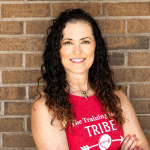 About the Author: Amber Toole
About the Author: Amber Toole
Amber Toole is an ACE Certified Personal Trainer with a Bachelor of Science degree in Physical Education and Health from Georgia Southern University. She has 30 years of experience in the Fitness Industry and loves to share her expertise with other Fitness Professionals. It is her life’s mission to spread the truth about fitness and nutrition through education. She is the owner of The Training Toole – a Fitness and Nutrition Studio in Ocala, Florida, an SCW Educator and Fit Pro Mentor.
Follow us on IG: https://www.instagram.com/scwmania/
Like our FB page: https://www.facebook.com/scwmania
Follow us on X: https://twitter.com/scw_mania
Connect with us on LinkedIn: https://www.linkedin.com/company/scwfit/
Looking for a New Job? SCW Can Help!
Facilities need you! Whether it’s Teachers, Trainers, Directors, or Managers, SCW’s new FREE JOB BOARD is supporting the industry’s need for qualified fitness pros.
We post openings in all three of our monthly e-newsletters: Spotlite, Health & Fitness Business News, and Tidal Waves which are emailed out to tens of thousands of fitness professionals teaching and training in all formats along with managers and directors at all fitness facilities: big box, gyms, boutique, studios, not for profits and independent centers.
Bilingual Fitness Professionals
Burnalong
Seeking certified professionals to deliver virtual(remote) Portuguese-language classes across various wellness categories for our diverse user base. Partners need to: record classes 5 minutes or longer, teach in certified area of expertise (fitness, wellness, medical, mindfulness, nutrition, etc.), post 2-5 times/month. Payment is quarterly revenue share based. Join Burnalong today!
Aqua Instructor
Central YMCA – Arlington, TX
We are looking for passionate certified aqua instructors for our summer outdoor pool classes. The class schedule begins the end of May and runs through early September and the class times are 7:15a and 8:15a.
Fitness Coordinator
Georgia Southern University – Statesboro, GA
This position develops and supervises a comprehensive group fitness program, to include small group training, and related special events.
Assistant Director, Fitness
Leonard J. Kaplan Center for Wellness – UNC Greensboro
The Assistant Director, Fitness is responsible for the overall design, management, and implementation of a comprehensive fitness program for the students, faculty, staff and UNC Greensboro community. This includes leadership of two professional positions and a graduate assistant as well as student employees.
Club Leader
Element3 Health – Chicago Heights, IL
Element 3 Health is looking for a skilled club leader to lead a club for older adults. Theses clubs include fitness, yoga, dance, and arts and crafts. This, is a unique opportunity to teach an in-person session, to actively train older adults and be responsible for your own club.
Exercise Physiologist
Woman’s Center for Wellness – Baton Rouge, LA
Conducts 1-on-1 and group training exercise sessions with cancer survivors, bone health sufferers, and other related diagnoses. Other duties include exercise testing and evaluation, and the development of appropriate exercise programs. Performs other duties assigned by department management. Must be knowledgeable of exercise standards and guidelines established by the ACSM.
 We’re always looking for great content highlighting the newest things in the world of fitness. Please submit your article directly to editor@scwfit.com for immediate consideration!
We’re always looking for great content highlighting the newest things in the world of fitness. Please submit your article directly to editor@scwfit.com for immediate consideration! Spotlite, April 9, 2025
Spotlite, January 5, 2025
Spotlite, November 11, 2024
Spotlite, September 27, 2024
Spotlite, August 31, 2024
Spotlite, July 26, 2024
Spotlite, June 22, 2024
Spotlite, May 23, 2024
Spotlite, April 26, 2024
Spotlite, March 22, 2024
Spotlite, February 19, 2024
Spotlite, January 20, 2024
Spotlite, December 21, 2023
Spotlite, November 18, 2023
Spotlite, October 22, 2023
Spotlite, September 21, 2023
Spotlite, August 19, 2023
Spotlite, July 19, 2023
Spotlite, June 19, 2023
Spotlite, May 18, 2023
Spotlite, April 21, 2023
Spotlite, March 28, 2023
Spotlite, February 18, 2023
Spotlite, January 21, 2023
Spotlite, December 16, 2022
Spotlite, November 19, 2022
Spotlite, October 22, 2022
Spotlite, September 24, 2022
Spotlite, August 23, 2022
Spotlite, July 22, 2022
Spotlite, June 20, 2022
Spotlite, May 18, 2022
Spotlite, April 20, 2022
Spotlite, March 25, 2022
Spotlite, February 17, 2022
Spotlite, January 14, 2022
Spotlite, December 17, 2021
Spotlite, November 18, 2021
Spotlite, October 25, 2021
Spotlite, September 16, 2021
Spotlite, August 9, 2021
Spotlite, July 10, 2021
Spotlite, June 8, 2021
Spotlite, May 14, 2021
Spotlite, April 30, 2021
Spotlite, March 30, 2021
Spotlite, February 23, 2021
Spotlite, January 20, 2021
Hyatt Regency Dulles
Herndon, VA
Hyatt Regency SF Airport
Burlingame, CA
Caribe Royale Orlando
Orlando, FL
May 1-4, 2025
May 2026
Grand Hyatt Atlanta Buckhead
Atlanta, GA
July 24-27, 2025
July 2026
Westin Galleria Dallas
Dallas, TX
August 21-24, 2025
August 28-30 2026
Rosemont Chicago O’Hare
Rosemont, IL
Oct. 2-5, 2025
Oct. 2-4 2026
Doubletree by Hilton
Danvers, MA
Nov. 13-16, 2025
Nov. 13-15, 2026



